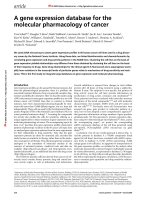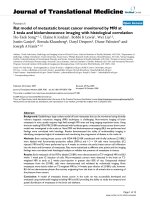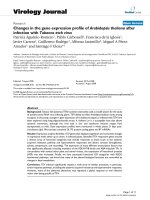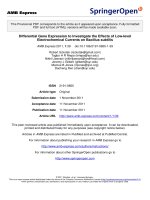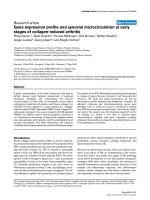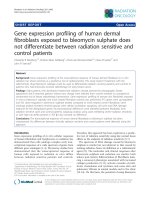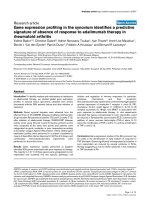Association between gene expression profile of the primary tumor and chemotherapy response of metastatic breast cancer
Bạn đang xem bản rút gọn của tài liệu. Xem và tải ngay bản đầy đủ của tài liệu tại đây (631.99 KB, 8 trang )
Savci-Heijink et al. BMC Cancer (2017) 17:755
DOI 10.1186/s12885-017-3691-9
RESEARCH ARTICLE
Open Access
Association between gene expression
profile of the primary tumor and
chemotherapy response of metastatic
breast cancer
Cemile Dilara Savci-Heijink1*, Hans Halfwerk1, Jan Koster2 and Marc Joan Van de Vijver1*
Abstract
Background: To better predict the likelihood of response to chemotherapy, we have conducted a study
comparing the gene expression patterns of primary tumours with their corresponding response to systemic
chemotherapy in the metastatic setting.
Methods: mRNA expression profiles of breast carcinomas of patients that later developed distant metastases were
analyzed using supervised and non-supervised classification techniques to identify predictors of response to
chemotherapy. The top differentially expressed genes between the responders and non-responders were identified and
further explored. An independent dataset which was generated to predict response to neo-adjuvant CT was utilized for
the purpose of validation. Response to chemotherapy was also correlated to the clinicopathologic characteristics,
molecular subtypes, metastatic behavior and survival outcomes.
Results: Anthracycline containing regimens were the most common first line treatment (58.4%), followed by nonanthracycline/non-taxane containing (25.8%) and taxane containing (15.7%) regimens. Response was achieved in 41.6% of
the patients to the first line CT and in 21.8% to second line CT. Response was not found to be significantly correlated to
tumour type, grade, lymph node status, ER and PR status. Patients with HER2+ tumours showed better response to
anthracycline containing therapy (p: 0.002). Response to first and second line chemotherapy did not differ among gene
expression based molecular subtypes (p: 0.236 and p: 0.20). Using supervised classification, a 14 gene response classifier
was identified. This 14-gene predictor could successfully predict the likelihood of better response to first and second line
CT (p: <.0001 and p: 0.761, respectively) in the training set. However, the predictive value of this gene set in data of
response to neoadjuvant chemotherapy could not be validated.
Conclusions: To our knowledge, this is the first study revealing the relation between gene expression profiles of the
primary tumours and their chemotherapy responsiveness in the metastatic setting. In contrast to the findings for
neoadjuvant chemotherapy treatment, there was no association of molecular subtype with response to chemotherapy in
the metastatic setting. Using supervised classification, we identified a classifier of chemotherapy response; however, we
could not validate this classifier using neoadjuvant response data.
Trial registration: Non applicable. Subjects were retrospectively registered.
Keywords: Adjuvant, Neoadjuvant, Chemosensitive, Chemoresistant
* Correspondence: ;
1
Department of Pathology, Academic Medical Center, Meibergdreef 9, 1105
Amsterdam, AZ, Netherlands
Full list of author information is available at the end of the article
© The Author(s). 2017 Open Access This article is distributed under the terms of the Creative Commons Attribution 4.0
International License ( which permits unrestricted use, distribution, and
reproduction in any medium, provided you give appropriate credit to the original author(s) and the source, provide a link to
the Creative Commons license, and indicate if changes were made. The Creative Commons Public Domain Dedication waiver
( applies to the data made available in this article, unless otherwise stated.
Savci-Heijink et al. BMC Cancer (2017) 17:755
Background
The main aim of treating metastatic breast cancer is to
prolong survival of the patients with acceptable toxicity
and to palliate the disease-related symptoms. Response
to combined chemotherapy agents varies between 50
and 70% in the metastatic setting [1, 2]. In order to
avoid unnecessary chemotherapy treatment it would be
of great benefit to be able to distinguish the group of patients which are not likely to respond to chemotherapy
in general and to specific chemotherapy regimens. The
decision to treat patients with metastatic breast cancer
with chemotherapy is usually taken depending on many
factors such as patient age and performance status, site
of metastasis, hormone receptor status and prior exposure to chemotherapy, [3, 4]. Commonly used first-line
therapeutic options in the metastatic setting include
anthracycline- and/or taxane-based regimens [5]. In case
of disease progression other cytotoxic agents may be
applied to maximize the duration of quality time for
these patients [6].
The current treatment approaches for metastatic disease consist to a large extent of trial-and-error type
models, as predictors of response are lacking. The response rate to the chemotherapy regimens and the median duration of survival differs between breast cancer
subtypes [7–11]. Several gene expression profiling studies aimed at the identification of a genomic predictor of
chemotherapy response in the neoadjuvant setting have
been performed and already provided important insights
[12–17]. However a clinically validated gene expression
profiling assay to predict the chemotherapy response has
not yet been accomplished. Gene expression profiling
studies of chemotherapy response in metastatic breast
cancer have thus far been lacking.
We have previously investigated the association between the gene expression patterns of primary tumours
and metastatic behavior in metastatic breast cancer [18].
In the current study, using the gene expression profiling data of 89 patients, the link between primary tumour
and chemotherapy response in the frame of metastatic
disease is explored. In order to develop genomic identifiers of chemotherapy responsiveness, gene expression
patterns of the primary tumours of the responders and
non-responders have been investigated.
Page 2 of 8
study protocol was approved by the Medical Ethical
Committee of the Academic Medical Center and permission to use the data of the patients from Netherlands
Cancer Institute was granted by the Core FacilityMolecular Pathology and Biobanking. Relevant clinical
data and detailed information on metastatic behavior
were abstracted from the clinical charts. Information related to metastatic behavior included data on site of metastasis (ever/never, first/not first and only/not-only for
each metastasis site), metastasis pattern (uni/multiple)
and metastasis timeline (early/late) has been previously
published [11]. Time to develop metastatic disease, time
from development of metastatic disease (metastasis specific survival, MSS) to last event and overall survival
(OS) were recorded. Last event date was defined as the
most recent follow up date for the patients who were
alive and time of death for the others.
Histopathologic examination of the sections from the
primary tumours was performed by two pathologists
(C.D.S-H and M.J.V.) and as needed immunohistochemical stains and in-situ hybridization were applied in order
to determine the hormone receptor and HER2 status as
previously described [11].
Chemotherapy data
For each patient, administered systemic therapy was recorded for the adjuvant and metastatic settings separately. The therapy given was grouped as hormonal
therapy (HT) and chemo-therapy (CT). In addition, the
type of the therapeutic agent, the duration and the
chronology of the therapy were noted. Due to the heterogeneity of the chemotherapy regimens, we have
grouped the chemotherapy regimens into 3 groups as:
anthracycline containing, taxane containing and nonanthracycline/non-taxane containing. Response to
chemotherapy in metastatic patients was assessed for
each line of chemotherapy according to RECIST [19] criteria and classified as complete response (CR), partial response (PR), stable disease (SD) and progressive disease.
For statistical purposes, CR and PR were considered as
response and SD and PD were considered as nonresponse. Response to first and second line CT and each
chemotherapeutic group was separately assessed. Response to the given chemotherapy group were scored as
response in case of response as first line treatment.
Methods
Patients and tumour samples
Gene expression profiling
Metastatic breast cancer patients from the Academic
Medical Center and Netherlands Cancer Institute (NCI)
were identified (n = 263) and a subgroup of patients
from whom frozen tumour material from the primary
tumour was available, were included in this study. This
group constituted of 118 patients whose primary tumours were diagnosed between 1984 and 2000. The
The gene expression profiling experiments have been
described previously and detailed information on
RNA amplification, labeling and hybridization can be
found at Illumina website ( />[18].The gene expression data was normalized utilizing robust spline normalization (rsn) and log2 transformed and followed by ComBat ( />
Savci-Heijink et al. BMC Cancer (2017) 17:755
jlab/wp-assets/ComBat/Abstract.html). Data analyses
were conducted using R2 (Microarray Analysis and
Visualization Platform), a publicly available web application ( />For each tumour, the previously assessed 70-gene prognostic signature [20] was used to categorize tumours as
good prognosis or poor prognosis signature. Genes were
mapped to the Illumina platform via Gene Symbol ID. 62
Genes were found be present on the Illumina platform
corresponding to 65 probes. The probe with the highest
variance across the samples was selected in the event of
existence of multiple probes for one gene. Tumours were
assigned into the good or poor prognostic group based on
the Pearson correlation coefficient between the centroids
of the original good prognosis template and the gene expression levels of each sample. Classification into molecular subtypes (basal type, HER2 like, luminal A and luminal
B type) were done using the genes from the PAM50 classifier [21]. The 21-gene recurrence score for each tumour
was calculated as described by King et al. [22].
Identification and validation of predictors for chemotherapy
response
To identify a gene expression predictor associated to response to chemotherapy, we used the one-way ANOVA
function in R2 to select from a set of 15,526 genes with
an expression level above background. 14 genes had a
significant different expression (p: <0.001) between the
group which the patient had a tumour response (CR and
PR) to first line chemotherapy and the group in which
the patient had no tumour response (SD and PD) to
chemotherapy were identified. For validation, there are
no published datasets for patients with metastatic disease; there are, however, various datasets of gene expression profiles of tumours from patients who underwent
neoadjuvant chemotherapy treatment. Therefore, the
predictive chemotherapy signature was then validated in
an independent data set using the K-means and t-test
function in R2. A data set (GSE25066) which includes
488 breast carcinomas with response data in the neoadjuvant setting was used for validation [12] .
To further investigate the association between this 14gene predictor and clinical variables including response
to chemotherapy multivariate logistic regression tests
were applied using SPSS Statistics for Windows (Release
version 21.0; IBM Corp.2012, Armond, NY). All statistical tests were two sided and p < 0.05 was considered
to be statistically significant.
Results
Gene expression profiles from primary tumours (n = 118)
were assessed using microarrays. All patients were known
to have developed distant metastasis and underwent (palliative) chemotherapy. The clinicopathologic features of
Page 3 of 8
the patients are displayed in Table 1. The mean age at
diagnosis was 50.77 years (range 28 to 85 years). Median
follow-up time was 63 months (range 9 to 211 months)
for all patients and 136.50 months (range 74 to
208 months) for the patients who were alive at last followup. In this study group, 17.2% (n = 21) previously received
neo-adjuvant systemic therapy and 80.4% (n = 98) adjuvant systemic therapy as part of the treatment of the primary tumour. Out of 98 patients who were given adjuvant
therapy 39.8% (n = 39) received only chemotherapy, 15.3%
(n = 15) received only hormonal therapy and 44.9%
(n = 44) received chemotherapy and hormonal therapy.
Adjuvant chemotherapy consisted of anthracycline containing regimens for 56.3%, non-anthracycline/non-taxane
containing regimens for 42.3% and taxane containing
drugs for 1.4% of the patients who received adjuvant
chemotherapy (n = 71). None of the patients received trastuzumab as adjuvant treatment.
In the metastatic setting all patients (n = 118) received
palliative systemic therapy. Of these patients 49.2%
(n = 58) received chemotherapy and hormonal therapy,
27.1% (n = 32) received only chemotherapy and 23.7%
(n = 28) only hormonal therapy in the course of metastatic
disease. The chemotherapeutic agents given in the metastatic setting were quite heterogeneous. As first line
chemotherapy, 58.4% (n = 52) received an anthracycline
containing regimen, 25.84% (n = 23) an nonanthracycline/non-taxane containing regimen and 15.73%
(n = 14) received a taxane containing regimen (total
Table 1 Clinicopathologic characteristics of the primary
tumours
N
%
68
55,7%
Age at diagnosis, years
<50
>50
54
44,3%
Histology
Ductal
105
86,8%
Lobular
12
9,9%
Other
4
3,3%
1
9
7,6%
2
69
58,5%
Tumour grade
Lymph node status
Neoadjuvant chemotherapy
Adjuvant therapy
3
40
33,9%
none
35
30,2%
1–3 positive
35
30,2%
>3 positive
46
39,7%
no
100
82,6%
yes
21
17,4%
none
23
19,0%
only CT
39
32,2%
only HT
15
12,4%
CT + HT
44
36,4%
Abbreviations: CT chemotherapy, HT hormonal therapy
Savci-Heijink et al. BMC Cancer (2017) 17:755
Page 4 of 8
n = 89). Second line CT was given to 63 patients and consisted of an anthracycline containing regimen for 22.2%
(n = 14), a non-anthracycline/non-taxane containing regimen for 36.5% (n = 23) and a taxane containing regimen
for 41.3% (n = 26) patients. Ten patients received a trastuzumab containing regimen as first line therapy.
The response rate for the first and second line chemotherapy was 41.6% and 21.8%, respectively. Patients who
received anthracycline containing therapy showed a response rate of 51.8%, patients who received non-taxane/
non-anthracycline containing therapy showed a response
rate of 24.3% and the ones who were given taxane containing therapy had a response rate of 30.6%. Table 2
shows the distribution of the administered chemotherapy and response rates among patients. Response to
chemotherapy was not found to be significantly correlated with histologic type, tumour grade and lymph node
status. Response to first line chemotherapy treatment
was better among patients who were younger than
50 years (p: 0.005).
ER and PR status were not associated with response to
chemotherapy treatment, whereas HER2 positive patients showed better response rate to anthracycline containing regimens (p: 0.002). Out of 13 HER2 positive
patients with good response to anthracycline containing
regimen, only 3 patients received trastuzumab for the
treatment of metastatic disease (23.1%).
When classified into molecular subtypes 95 of the tumours classified as luminal (59, luminal A; 36, luminal
B), 16 tumours as basal, 10 tumour as HER2-like and
one tumour as normal like subtype. Out of luminal type
tumours 65 and 49; of basal type tumours 16 and 8, of
HER2-like tumours 9 and 5 received first and second
line chemotherapy respectively. Response to first and
second line chemotherapy did not differ among the molecular subtypes (p: 0.236 and p: 0.20). Molecular subtypes and their corresponding metastatic behavior have
already been published [18].
Analyses were further carried out based on specific
chemotherapy regimen. Anthracycline containing therapy was given to 41 patients with luminal type tumours,
7 patients with HER2-like tumours and 8 patients with
basal type tumours as first or second line CT in the
metastatic setting. Among these patients 51.21% of the
patients with luminal type tumours, 71.4% of the patients with HER2-like tumours and 37.5% of the patients
with basal type tumours showed response to anthracycline containing therapy (p: 0.624). Non-anthracycline/
non-taxane containing therapy was given to 28 patients
with luminal tumours, 3 patients with HER-2 type tumours and 6 patients with basal type tumours. Response
rate to non-anthracycline/non-taxane containing regimens was 25%, 33.3% and 16.7% of the patients with luminal, HER2-type and basal type tumours, respectively
(p: 0.954).
Taxane containing therapy was administered to 23 patients with luminal type tumours, 3 patients with HER2type tumours and 10 patients with basal type tumours.
Of luminal type tumours 39.1%, of HER2-type tumours
33.3% and of basal type tumours 10% responded to taxane containing therapy (p: 0.033). The association between the molecular subtypes of the tumours and their
response status is displayed in Table 3.
The group of patients who received trastuzumab was
composed of 6 with luminal type tumours, 3 with
HER2-like tumours an 1 with a basal type tumour.
There was no significant association between trastuzumab use and chemotherapy response (p: 0.291).
Table 2 Distribution of the administered CT and response rates
among patients
First line chemotherapy
A-CT
NA/NT-CT
T-CT
Second line chemotherapy
A-CT
NA/NT-CT
T-CT
Response
N
%
no
25
48,1%
yes
27
51,9%
no
14
66,7%
yes
7
33,3%
no
11
78,6%
yes
3
21,4%
no
10
yes
no
Table 3 The association between the molecular subtypes of the
primary tumours and chemotherapy response rates
Response
Molecular subtype
Basal
Luminal A
Luminal B
HER2
N
N
%
%
N
%
N
no
5
62,5% 12
48,0%
8
50,0%
2
28,6%
71,4%
yes
3
37,5% 13
52,0%
8
50,0%
5
71,4%
4
28,6%
NA/NT-CT no
5
83,3% 12
75,0%
9
75,0%
2
66,7%
20
87,0%
yes
1
16,7% 4
25,0%
3
25,0%
1
33,3%
yes
2
8,7%
0
0
no
17
68,0%
no
9
90,0% 4
36,4%
10 83,3%
2
66,7%
yes
8
32,0%
yes
1
10,0% 7
63,6%
2
1
33,3%
Abbreviations: A-CT anthracycline containing chemotherapy, NA/NT-CT nonanthracyline/non-taxane containing chemotherapy, T-CT taxane
containing chemotherapy
A-CT
0
T-CT
16,7%
%
Abbreviations: A-CT anthracycline containing chemotherapy, NA/NT-CT nonanthracyline/non-taxane containing chemotherapy, T-CT taxane
containing chemotherapy
Savci-Heijink et al. BMC Cancer (2017) 17:755
Page 5 of 8
Identification of genomic predictor(s) for chemotherapy
response
Using supervised classification the differentially expressed
genes between the primary tumours of metastatic breast
cancer patients in responders (n = 37) and nonresponders for the first line chemotherapy were explored
(n = 52). Using supervised classification the top 14 differentially expressed genes between responders and nonresponders were selected for further analyses. These 14
differentially expressed genes are listed as BGN, BMP7,
C16ORF35, C20ORF111, CCNO, FLNC, HMG20B,
KLHL24,, LOC727865, MAPK10, MRPS6, NDUFS8,
THRA and VPS37C. Three of these genes were found to
be down-regulated and the rest to be up-regulated in the
group of patients with a good response to chemotherapy
(Table 4). Figure 1 displays the expression profiling pattern of 14 differentially expressed genes among the patients. This heat map shows that the set of 14 genes
separates the responders and non-responders in group of
89 tumours (p: < 0.001).
The correlation between these 14 differentially expressed
genes and chemotherapy response was further explored. In
the group of patients who received chemotherapy in the
metastatic setting, 43 patients had a tumour with a “chemotherapy responsive” gene expression profile. Out of those
43 patients, 76.7% (n = 33) showed good response to first
line therapy; whereas out of 46 patients who were predicted
to be non-responsive to chemotherapy 91.3% had indeed
no response (p: < .0001, sensitivity: 89.2%and specificity:
80.8%) In the case of response to second line CT, 37 were
predicted to have good response with the 14-gene predictor
and 24.3%(n = 9) of these showed good response; out of 27
tumours which were predicted as non-responder
81.5%(n = 22) had no response to CT (p: 0.249, sensitivity:64.3% and specificity: 44%). However, as this was the set
of tumours in which the chemotherapy response signature
was identified, validation in an independent dataset is
required.
No other gene data set with chemotherapy response
data in the metastatic setting was available for the
validation of this gene set. Therefore an independent
dataset with available chemotherapy response data for
neo-adjuvant administered chemotherapy was utilized
[12]. This data set included total 488 tumours with available information on chemotherapy response and 205 of
these were predicted as responsive with the 14-gene predictor. Of these 205 tumours which were predicted as
responsive, 47 (22.9%) showed response to chemotherapy. Out of 283 tumours which were assessed as nonresponsive with the predictor, 231 (81.6%) had actually
no response to CT (p:0.254, sensitivity: 47.5% and specificity: 59.4%). The validation of this 14-gene predictor is
summarized in Table 4.
Other signatures which were developed to predict the
response to neoadjuvant CT were also tested in this
study group. DLDA30 signature correctly predicted
76.3% of the responsive and 62% of the non-responsive
tumours (p: 6,5E-01). In contrast, the genomic grade
index (GG1) and genomic predictor of Hatzis et al. were
not able to distinguish the responsive and nonresponsive groups (p: 0.317 and p: 0.212, respectively).
The relationship between the 21-gene recurrence score
and CT response in our study set was also further investigated in the subgroup of ER-positive/HER2-negative
tumours. Out of 74 tumours 40.5% (n = 30) had lowrisk, 16.2% (n = 12) had intermediate-risk and 43.2%
(n = 32) had high- risk recurrence scores. A high-risk
recurrence scores was found to be correlated with
shorter overall survival time and time to develop metastases (p: 0.016 and p: 0.033, respectively); but not correlated
with survival time after the development of metastatic disease (p: 0.117). The recurrence scores were not found to
be correlated to chemotherapy response (p: 0.854).
Additional analyses to explore the correlation of the 14gene predictor to the site of metastasis (bone metastasis
ever, visceral metastasis ever, bone only metastasis and visceral only metastasis) have not revealed any significant relation (p: 0.72, p:0.58, p:0.38 and p:0.80, respectively). Yet
it was found that this 14-gene predictor was significantly
correlated to time to metastasis (metastasis within 5 year
Table 4 Performance of the 14-gene predictor for chemotherapy response
Training data set
14-gene predictor a
Independent data set
Signature
Chemotherapy response
yes
no
p
yes
no
All
present
33
10
2.24E-11
47
158
absent
4
42
52
231
ER-positive
present
23
2
1.02E-10
15
101
absent
5
35
15
154
ER-negative
present
9
3
3.37E-04
41
63
absent
0
12
27
66
Abbreviations: ER estrogen receptor
a
The 14-gene predictor developed in this study
p
0.254
0.327
0.136
Savci-Heijink et al. BMC Cancer (2017) 17:755
Page 6 of 8
Fig. 1 Heat map showing the gene expression pattern of 14-gene predictor for chemotherapy response. Heat map shows the gene expression
profiling pattern of the 14 differentially expressed genes among 89 tumours. Primary tumours of the patients who respond to CT are illustrated in
yellow and the ones without response are in blue. For each primary tumour the expression level of the specific gene is exhibited as red, if
up-regulated and green, if down-regulated
vs later than 5 year), more specifically tumours with
present 14-gene expression profile developing metastases
at a later time than the others (p: 0.021).
Survival analyses revealed no significant association
between survival time (overall and metastasis specific)
and chemotherapy responsiveness. Survival time also did
not differ between patients with a responsive 14-gene
predictor and the ones without it.
Discussion
With the purpose of identifying a genomic predictor for
response to chemotherapy in metastatic breast cancer,
we have compared gene expression profiles of primary
breast carcinomas to their response to chemotherapy
treatment. We have identified a 14 gene expression profile associated with response to chemotherapy. This gene
set was able to successfully predict the group of primary
tumours which were more likely to respond to chemotherapy in the training set. We do not have access to a
validation cohort of tumours from patients with metastatic breast cancer; therefore, we have studied the predictive value of the 14 gene predictive profile in
published series of tumours from patients who underwent neoadjuvant chemotherapy treatment.
Specifically, Hatzis et al. have introduced a predictive
test for neoadjuvant chemotherapy among patients with
HER2-negative tumours. The chemopredictive test algorithm developed by this study was shown to predict the
chemosensitivity with positive predictive value of 56%
(95% CI, 31%–78%) and absolute risk reduction of 18%
(95% CI, 6%–28%). When compared to the other predictive signatures such as genomic grade index (GG1),
PAM50 and DLDA30 [13, 14, 21], the predictive algorithm of Hatzis et al. had greater positive predictive
value in a validation cohort.
Neoadjuvant chemotherapy is increasingly employed
for the treatment of breast cancer and predictors of
response to neoadjuvant chemotherapy has been previously studied by several groups. Especially triple negative
breast cancer (TNBC), which is characterized by lacking
expression of ER, PR and HER-2, has shown to be more
sensitive to systemic chemotherapy compared to the
non-TNBC group. In particular, pathologic complete remission (pCR) has been reported to be achieved in 21.6–
45% of TNBC patients. In contrast, hormone receptor
positive tumours have been shown to be associated with
very low pCR rates (4.9% -11%) [23–27]. Treatment of
patients with HER2-positive tumours with chemotherapy plus HER2 targeted neoadjuvant therapy results in
pCR rates of approximately 65% with 37% relative improvement in overall survival and an increase in 10year overall survival rate from 75.2% to 84% [28–31].
Gene expression based analyses have shown similar results with basal like and HER2-type tumours having
better pCR response to neoadjuvant chemotherapy
(41.7% - 48.8%), compared to luminal type tumours
which have shown to have response rates ranging from
2% to 8.2% [26, 32]. It is also known that, regardless of
hormone receptor status and intrinsic subtype of the
tumour, patients with residual disease after neoadjuvant
chemotherapy have significantly shorter overall and
disease free survival than patients who achieve pCR
[23–25]. In this study identified chemotherapy response
rates in the metastatic setting and their association with
molecular subtypes and hormone receptor status differed from the ones in the neoadjuvant setting. Response rates to first line therapy given for metastatic
disease was not found to be significantly different between molecular subtypes, i.e. basal like tumours and
HER2-type tumours did not show better response rates
compared to the luminal type tumours. On the other
hand, HER-2 positive tumours were associated with
better response which is in agreement with published
studies [33, 34].
Savci-Heijink et al. BMC Cancer (2017) 17:755
Recently, the Translational Breast Cancer Research
Consortium (TBCRC) has conducted a study to explore
the usefulness of the 21-gene recurrence score (RS) in
predicting response to therapy among breast cancer patients presenting with Stage IV disease [22]. In the group
of 69 patients with ER-positive/HER2-negative tumours,
they have found that both time to first progression
(TTP) and 2 year overall survival (OS) time were shorter
for the patients with high-risk RS values (≥ 31) and who
received first line endocrine therapy. There were no differences by means of TTP and 2-year OS in the group of
patients with similarly high-risk RS values who received
first-line chemotherapy. Therefore, the 21-gene RS has
been suggested as a tool for selection of the patients presenting with stage IV ER-positive/HER2-negative breast
cancer who may benefit from first-line chemotherapy. In
the current study we have shown that ER-positive/HER2negative tumours with high-risk recurrence scores had
shorter time to develop metastatic disease and shorter
overall survival, however we were not able to confirm an
association with chemotherapy response.
In this study several limitations have been recognized.
As already mentioned, heterogeneity of the given chemotherapeutic agents and non-availability of an independent
gene expression data set with CT response information in
the metastatic setting are the main limitations to be acknowledged. Nonetheless, the detailed information on response to CT in the setting of metastatic disease in a
group of 118 patients is one of the strengths of this study.
Conclusions
We present a comprehensive study comparing the gene
expression patterns of primary tumours from metastatic
breast cancer patients according to their responsiveness of
chemotherapy during their treatment of metastatic disease. The 14 differentially expressed genes among these
two groups have been further investigated and led to the
exploration of couple genes that might play role in the response to CT. In contrast to the findings for neoadjuvant
chemotherapy treatment, there was no association of molecular subtype with response to chemotherapy in the
metastatic setting. Using supervised classification, we
identified a classifier of chemotherapy response; however,
we could not validate this classifier using neoadjuvant response data. We believe that the data generated in this
study may inspire new studies leading to development of
improved and individualized therapy strategies in treatment of metastatic breast cancer.
Additional file
Additional file 1: Illumina microarray data generated in this study.
(XLSX 160281 kb)
Page 7 of 8
Abbreviations
CT: Chemotherapy; ER: Estrogen receptor; HER2: Human epidermal growth
factor receptor 2; HT: Hormonal therapy; MBC: Metastatic breast cancer;
MSS: Metastasis specific survival; OS: Overall survival; PR: Progesterone
receptor; RECIST: Response evaluation criteria in solid tumours
Acknowledgements
Not applicable.
Funding
This research was supported by the Center for Translational Molecular
Medicine (BreastCARE).
Availability of data and materials
The authors declare that the raw data supporting the findings of this study
are available within the article [and its supplementary information files]. The
microarray data and corresponding accession numbers are included as
Additional file 1.
Authors’ contributions
Conceived and designed the study: CDS-H, MJV. Contributed reagents/materials/
analysis tools: HH. Analyzed the data: CDS-H, HH, JK, MJV. Drafted the paper: CDSH and MJV. Read and approved the final manuscript: CDSH, HH, JK and MJV.
Ethics approval and consent to participate
This study material was strictly handled after coding of the data according to
national ethical guidelines of ‘Code for Proper Secondary Use of Human
Tissue’ developed by Federation of Medical Societies (FMWV) in the
Netherlands [35]. The entire study protocol was approved by the Medical
Ethical Committee of the Academic Medical Center. The need for obtaining
informed consent was waived by this committee.
Consent for publication
Not applicable.
Competing interests
The authors declare that they have no competing interests.
Publisher’s Note
Springer Nature remains neutral with regard to jurisdictional claims in
published maps and institutional affiliations.
Author details
1
Department of Pathology, Academic Medical Center, Meibergdreef 9, 1105
Amsterdam, AZ, Netherlands. 2Department of Oncogenomics, Academic
Medical Center, Meibergdreef 9, 1105 Amsterdam, AZ, Netherlands.
Received: 24 March 2017 Accepted: 16 October 2017
References
1. El Saghir NS, Tfayli A, Hatoum HA, Nachef Z, Dinh P, Awada A. Treatment of
metastatic breast cancer: state-of-the-art, subtypes and perspectives. Crit
Rev Oncol Hematol. 2011;80(3):433–49.
2. Hortobagyi GN. Treatment of breast cancer. N Engl J Med. 1998;339(14):
974–84.
3. Johnston SR. The role of chemotherapy and targeted agents in patients
with metastatic breast cancer. Eur J Cancer. 2011;47(Suppl 3):S38–47.
4. Jones SE. Metastatic breast cancer: the treatment challenge. Clin Breast
Cancer. 2008;8(3):224–33.
5. Beslija S, Bonneterre J, Burstein H, Cocquyt V, Gnant M, Goodwin P,
Heinemann V, Jassem J, Kostler WJ, Krainer M, et al. Second consensus
on medical treatment of metastatic breast cancer. Ann Oncol. 2007;
18(2):215–25.
6. Lin NU, Thomssen C, Cardoso F, Cameron D, Cufer T, Fallowfield L,
Francis PA, Kyriakides S, Pagani O, Senkus E, et al. International
guidelines for management of metastatic breast cancer (MBC) from the
European School of Oncology (ESO)-MBC task force: surveillance,
staging, and evaluation of patients with early-stage and metastatic
breast cancer. Breast. 2013;22(3):203–10.
Savci-Heijink et al. BMC Cancer (2017) 17:755
7.
8.
9.
10.
11.
12.
13.
14.
15.
16.
17.
18.
19.
20.
21.
22.
23
24
25
26
Chia SK, Speers CH, D'yachkova Y, Kang A, Malfair-Taylor S, Barnett J,
Coldman A, Gelmon KA, O'reilly SE, Olivotto IA. The impact of new
chemotherapeutic and hormone agents on survival in a population-based
cohort of women with metastatic breast cancer. Cancer. 2007;110(5):973–9.
Dawood S, Broglio K, Gonzalez-Angulo AM, Buzdar AU, Hortobagyi GN,
Giordano SH. Trends in survival over the past two decades among white
and black patients with newly diagnosed stage IV breast cancer. JClinOncol.
2008;26(30):4891–8.
Giordano SH, Buzdar AU, Smith TL, Kau SW, Yang Y, Hortobagyi GN. Is
breast cancer survival improving. Cancer. 2004;100(1):44–52.
Kennecke H, Yerushalmi R, Woods R, Cheang MC, Voduc D, Speers CH,
Nielsen TO, Gelmon K. Metastatic behavior of breast cancer subtypes.
JClinOncol. 2010;28(20):3271–7.
Savci-Heijink CD, Halfwerk H, Hooijer GK, Horlings HM, Wesseling J, van de
Vijver MJ. Retrospective analysis of metastatic behaviour of breast cancer
subtypes. Breast Cancer Res Treat. 2015;150(3):547–57.
Hatzis C, Pusztai L, Valero V, Booser DJ, Esserman L, Lluch A, Vidaurre T,
Holmes F, Souchon E, Wang H, et al. A genomic predictor of response and
survival following taxane-anthracycline chemotherapy for invasive breast
cancer. JAMA. 2011;305(18):1873–81.
Hess KR, Anderson K, Symmans WF, Valero V, Ibrahim N, Mejia JA, Booser D,
Theriault RL, Buzdar AU, Dempsey PJ, et al. Pharmacogenomic predictor of
sensitivity to preoperative chemotherapy with paclitaxel and fluorouracil,
doxorubicin, and cyclophosphamide in breast cancer. J Clin Oncol. 2006;
24(26):4236–44.
Liedtke C, Hatzis C, Symmans WF, Desmedt C, Haibe-Kains B, Valero V,
Kuerer H, Hortobagyi GN, Piccart-Gebhart M, Sotiriou C, et al. Genomic
grade index is associated with response to chemotherapy in patients with
breast cancer. J Clin Oncol. 2009;27(19):3185–91.
Press MF, Sauter G, Buyse M, Bernstein L, Guzman R, Santiago A, Villalobos
IE, Eiermann W, Pienkowski T, Martin M, et al. Alteration of topoisomerase IIalpha gene in human breast cancer: association with responsiveness to
anthracycline-based chemotherapy. J Clin Oncol. 2011;29(7):859–67.
Pusztai L: Markers predicting clinical benefit in breast cancer from
microtubule-targeting agents. Ann Oncol 2007, 18 Suppl 12:xii15–20.
Rouzier R, Rajan R, Wagner P, Hess KR, Gold DL, Stec J, Ayers M, Ross JS,
Zhang P, Buchholz TA, et al. Microtubule-associated protein tau: a marker of
paclitaxel sensitivity in breast cancer. Proc Natl Acad Sci U S A. 2005;102(23):
8315–20.
Savci-Heijink CD, Halfwerk H, Koster J, van de Vijver MJ. A novel gene
expression signature for bone metastasis in breast carcinomas. Breast
Cancer Res Treat. 2016;156(2):249–59.
Eisenhauer EA, Therasse P, Bogaerts J, Schwartz LH, Sargent D, Ford R,
Dancey J, Arbuck S, Gwyther S, Mooney M, et al. New response evaluation
criteria in solid tumours: revised RECIST guideline (version 1.1). EurJCancer.
2009;45(2):228–47.
van de Vijver MJ, He YD, van't Veer LJ, Dai H, Hart AA, Voskuil DW, Schreiber
GJ, Peterse JL, Roberts C, Marton MJ et al: A gene-expression signature as a
predictor of survival in breast cancer. NEnglJMed 2002, 347(25):1999–2009.
Parker JS, Mullins M, Cheang MC, Leung S, Voduc D, Vickery T, Davies S,
Fauron C, He X, Hu Z, et al. Supervised risk predictor of breast cancer based
on intrinsic subtypes. J Clin Oncol. 2009;27(8):1160–7.
King TA, Lyman JP, Gonen M, Voci A, De Brot M, Boafo C, Sing AP, Hwang
ES, Alvarado MD, Liu MC, et al. Prognostic impact of 21-gene recurrence
score in patients with stage IV breast cancer: TBCRC 013. J Clin Oncol. 2016;
34(20):2359–65.
Carey LA, Dees EC, Sawyer L, Gatti L, Moore DT, Collichio F, Ollila DW, Sartor
CI, Graham ML, Perou CM. The triple negative paradox: primary tumor
chemosensitivity of breast cancer subtypes. Clinical cancer research : an
official journal of the American Association for Cancer Research. 2007;13(8):
2329–34.
Guarneri V, Lenihan DJ, Valero V, Durand JB, Broglio K, Hess KR, Michaud LB,
Gonzalez-Angulo AM, Hortobagyi GN, Esteva FJ. Long-term cardiac
tolerability of trastuzumab in metastatic breast cancer: the M.D. Anderson
cancer center experience. J Clin Oncol. 2006;24(25):4107–15.
Liedtke C, Mazouni C, Hess KR, Andre F, Tordai A, Mejia JA, Symmans WF,
Gonzalez-Angulo AM, Hennessy B, Green M, et al. Response to neoadjuvant
therapy and long-term survival in patients with triple-negative breast
cancer. J Clin Oncol. 2008;26(8):1275–81.
Lips EH, Mulder L, de Ronde JJ, Mandjes IA, Koolen BB, Wessels LF,
Rodenhuis S, Wesseling J. Breast cancer subtyping by
Page 8 of 8
27
28
29
30
31
32
33
34
35
immunohistochemistry and histological grade outperforms breast cancer
intrinsic subtypes in predicting neoadjuvant chemotherapy response. Breast
Cancer Res Treat. 2013;140(1):63–71.
Ring AE, Smith IE, Ashley S, Fulford LG, Lakhani SR. Oestrogen receptor
status, pathological complete response and prognosis in patients receiving
neoadjuvant chemotherapy for early breast cancer. Br J Cancer. 2004;91(12):
2012–7.
Buzdar AU, Ibrahim NK, Francis D, Booser DJ, Thomas ES, Theriault RL,
Pusztai L, Green MC, Arun BK, Giordano SH, et al. Significantly higher
pathologic complete remission rate after neoadjuvant therapy with
trastuzumab, paclitaxel, and epirubicin chemotherapy: results of a
randomized trial in human epidermal growth factor receptor 2-positive
operable breast cancer. J Clin Oncol. 2005;23(16):3676–85.
Perez EA, Romond EH, Suman VJ, Jeong JH, Sledge G, Geyer CE Jr, Martino
S, Rastogi P, Gralow J, Swain SM, et al. Trastuzumab plus adjuvant
chemotherapy for human epidermal growth factor receptor 2-positive
breast cancer: planned joint analysis of overall survival from NSABP B-31
and NCCTG N9831. J Clin Oncol. 2014;32(33):3744–52.
Piccart-Gebhart MJ, Procter M, Leyland-Jones B, Goldhirsch A, Untch M,
Smith I, Gianni L, Baselga J, Bell R, Jackisch C, et al. Trastuzumab after
adjuvant chemotherapy in HER2-positive breast cancer. N Engl J Med. 2005;
353(16):1659–72.
Romond EH, Perez EA, Bryant J, Suman VJ, Geyer CE, Jr., Davidson NE, TanChiu E, Martino S, Paik S, Kaufman PA et al: Trastuzumab plus adjuvant
chemotherapy for operable HER2-positive breast cancer. N Engl J Med 2005,
353(16):1673–1684.
Rouzier R, Perou CM, Symmans WF, Ibrahim N, Cristofanilli M, Anderson K,
Hess KR, Stec J, Ayers M, Wagner P, et al. Breast cancer molecular subtypes
respond differently to preoperative chemotherapy. Clinical cancer research :
an official journal of the American Association for Cancer Research. 2005;
11(16):5678–85.
Andre F, Mazouni C, Liedtke C, Kau SW, Frye D, Green M, Gonzalez-Angulo
AM, Symmans WF, Hortobagyi GN, Pusztai L. HER2 expression and efficacy
of preoperative paclitaxel/FAC chemotherapy in breast cancer. Breast
Cancer Res Treat. 2008;108(2):183–90.
Pritchard KI, Shepherd LE, O'Malley FP, Andrulis IL, Tu D, Bramwell VH,
Levine MN. National Cancer Institute of Canada clinical trials G: HER2 and
responsiveness of breast cancer to adjuvant chemotherapy. N Engl J Med.
2006;354(20):2103–11.
Vermeulen E, Geesink I, Schmidt MK, Steegers C, Verhue D, Brom FW,
Aaronson NK, van Leeuwen FE. secondary use of human tissue: consent
and better information required. NedTijdschrGeneeskd. 2009;153:A948.
Submit your next manuscript to BioMed Central
and we will help you at every step:
• We accept pre-submission inquiries
• Our selector tool helps you to find the most relevant journal
• We provide round the clock customer support
• Convenient online submission
• Thorough peer review
• Inclusion in PubMed and all major indexing services
• Maximum visibility for your research
Submit your manuscript at
www.biomedcentral.com/submit
